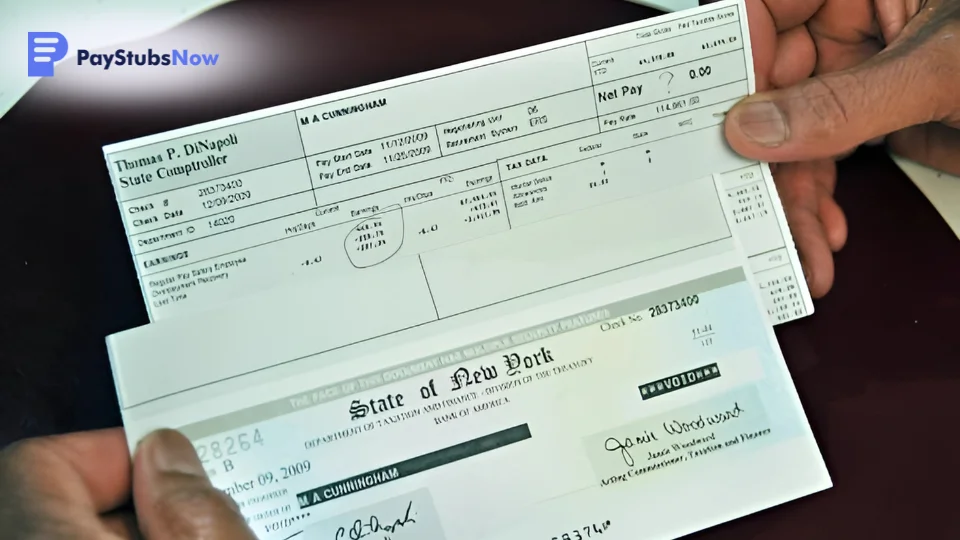Fringe benefits are more than just perks; they're a big part of what makes a job worthwhile. Things like health insurance, PTO, and even company cars can boost satisfaction and help businesses keep great people.
In this post, we'll explain what fringe benefits are, which ones are taxable, and how they're calculated. You'll learn why they matter for your business and how to stay compliant.
We'll also highlight how Paystubsnow helps organizations include fringe benefits on professional paystubs, without any complex payroll tools required.
Main Takeaways From This Article:
- Fringe benefits are non-wage perks provided by employers, such as health insurance, PTO, or education assistance, and can be either taxable or non-taxable
- Most fringe benefits must be valued and reported as part of an employee's compensation, though the IRS excludes some common items like health premiums and childcare assistance
- Employers use fringe benefits to attract and retain talent, boost morale, and even gain tax advantages for themselves and their employees.
- Examples of taxable fringe benefits include company cars, bonuses, and excess mileage, while non-taxable benefits include medical coverage, dependent care, and de minimis perks
- Paystubsnow helps simplify payroll reporting by allowing users to easily include fringe benefits on professional paystubs, making income documentation more accurate and transparent
What Are Fringe Benefits?

Fringe benefits, often called perks or fringe pay, are a form of non-wage compensation given to employees on top of their regular salary. These benefits are a crucial part of any competitive compensation package, helping businesses attract and retain valuable team members.
Here's a brief overview of the key regulations and acts that oversee fringe benefits:
- Internal Revenue Code (IRC): The IRC stipulates which benefits are considered taxable and nontaxable. For example, while health insurance premiums paid by an employer are typically tax-exempt for the employee, other benefits like personal use of a company car are taxable.
- Employee Retirement Income Security Act (ERISA): This act safeguards employee rights regarding employer-sponsored retirement plans and certain welfare benefit plans, encompassing some fringe benefits. ERISA mandates specific standards for plan administration, reporting, and participant disclosures.
- Affordable Care Act (ACA): The ACA plays a role in health-related fringe benefits. It mandates that employers of a certain size offer health insurance to their employees and outlines the minimum coverage standards these plans must meet.
- Americans With Disabilities Act (ADA) and Family and Medical Leave Act (FMLA): Although these laws don't directly regulate fringe benefits, they have a significant impact. The ADA ensures that certain employer-provided benefits, like medical leave or disability accommodations, are non-discriminatory. Similarly, the FMLA guarantees eligible employees a leave of absence for medical reasons or to care for family members.
Are Fringe Benefits Taxable?
 Most fringe benefits are considered taxable income by the IRS and must be included in an employee's gross income. This means the fair market value of the benefit is added to their wages for tax purposes.
Most fringe benefits are considered taxable income by the IRS and must be included in an employee's gross income. This means the fair market value of the benefit is added to their wages for tax purposes.
However, the IRS specifically excludes certain benefits from taxation. Common examples of non-taxable benefits include health plan contributions, achievement awards (up to a limit), and dependent care assistance.
It's crucial to understand which perks are taxable to ensure correct payroll processing and tax reporting for your business. Misreporting fringe benefits can lead to compliance issues, tax penalties, and employee confusion, especially during tax season.
Keeping detailed records and using tools that separate taxable and non-taxable compensation can make year-end reporting faster and more accurate for everyone involved.
Why Do Employers Offer Fringe Benefits?
Employers offerfringe benefits to attract, motivate, and retain top talent in a competitive job market. These perks can significantly improve employee satisfaction, boost morale, and increase loyalty. Key advantages include:
- Attracting Talent: A strong benefits package can make a job offer more appealing than a competitor's, even when the base salary is comparable. Companies offering comprehensive health insurance, generous PTO, and retirement matching often gain an edge in recruiting high-demand professionals.
- Improving Retention: Valued employees are more likely to stay with a company long-term when they receive meaningful benefits. Research shows that workers with good health coverage and retirement plans typically remain 2-3 years longer with their employers than those without these benefits.
- Boosting Productivity: Benefits like wellness stipends and paid time off can reduce stress and prevent burnout. When employees have access to mental health resources, fitness subsidies, and adequate recovery time, they typically show higher engagement levels and fewer sick days throughout the year.
- Providing Tax Advantages: Certain benefits can be tax-advantaged for both the employer and the employee. For example, employers can deduct contributions to qualified retirement plans as business expenses , while employees can reduce their taxable income through pre-tax contributions to health insurance premiums and FSA accounts.
What Are Common Examples of Fringe Benefits?
 Fringe benefits vary widely by industry and company. Let's break down the fringe benefits by taxable and nontaxable examples.
Fringe benefits vary widely by industry and company. Let's break down the fringe benefits by taxable and nontaxable examples.
Taxable Fringe Benefits
- Paid Time Off (PTO): Vacation days , sick leave, and paid holidays.
- Company-Provided Assets: Use of a company car, laptop, or cell phone.
- Bonuses: Cash bonuses are a straightforward taxable benefit. They are considered additional income and taxed at the employee's regular income tax rate.
- Awards and Prizes: Monetary awards and non-cash prizes like vacations or vehicles, unless given as recognition for service or safety achievements, are generally taxable. The value of non-cash prizes is determined by their fair market value.
- Moving Expense Reimbursements: These are taxable to the employee unless they are specifically for a military move.
- Excess Mileage Allowances: Reimbursements above the IRS-approved mileage rate are taxable. This is because the IRS sets a standard mileage rate to account for the operational costs of using a personal vehicle for business. Reimbursements exceeding that rate are considered additional compensation to the employee.
- Group Term Life Insurance: Coverage over $50,000 provided to an employee is taxable on the amount of premium attributable to the excess coverage.
Nontaxable Fringe Benefits
- Health Insurance: Employer-paid premiums for medical, dental, and vision coverage are generally tax-free, reducing taxable income and saving employees money.
- Educational Assistance: Up to $5,250 yearly in employer-provided education help is tax-free, though programs must meet IRS requirements.
- Dependent Care Assistance: Tax-free benefits for childcare or elder care up to $5,000 for joint filers or $2,500 for separate filers.
- Employee Discounts: Discounts on company products or services are tax-free if they're reasonable and available to most employees.
- Retirement Planning Services: Employer-provided financial advisors or planning resources are typically tax-free.
How Are Fringe Benefits Calculated and Valued?
 For payroll and tax purposes, fringe benefits must be assigned a monetary value. The value is typically determined by its fair market value (FMV), the amount an employee would have to pay for the same benefit on the open market.
For payroll and tax purposes, fringe benefits must be assigned a monetary value. The value is typically determined by its fair market value (FMV), the amount an employee would have to pay for the same benefit on the open market.
This value is important for ensuring compliance with labor laws and accurately reportingan employee's total compensation. Accurately reporting fringe benefits can also help employees when applying for loans or proving income for housing and insurance purposes.
For example, if a company provides an employee with a gym membership that typically costs $50 per month at a local fitness center, that $50 is considered the monthly FMV of the benefit. If the benefit is taxable, that amount would be added to the employee's gross income for that pay period.
There are a few other valuation methods that may apply in specific scenarios, including:
- General Valuation Rule: Uses the FMV of a benefit unless a specific exception applies.
- Special Valuation Rules: Used for specific benefits like employer-provided vehicles or group term life insurance. These rules account for factors like mileage, personal use, or the age of the employee.
- De Minimis Benefits: These are small enough (e.g., occasional snacks or office gifts) that they are excluded from needing valuation.
It's also important to consider timing; fringe benefits must be reported in the correct tax year and pay period . This means employers need systems in place to calculate, document, and apply benefit values in real time or at regular intervals. Inaccurate or missed reporting can lead to payroll errors, compliance issues, or employee confusion during tax season.
Platforms like Paystubsnow simplify this process by allowing users to manually enter and label fringe benefit values directly on a paystub . This ensures total compensation is transparent, easy to track, and properly documented for both personal and professional use, without requiring complex payroll software or accountant oversight.
Track Fringe Benefits with Ease Using Paystubsnow
Fringe benefits play a vital role in shaping a complete compensation package. From healthcare and paid time off to employee discounts and educational support, these non-wage perks help businesses attract talent, improve retention, and support employee well-being. But they also come with reporting responsibilities, especially when it comes to determining which benefits are taxable and how they're valued.
With Paystubsnow , you can easily include fringe benefits on professional paystubs, no complex software needed. It's a fast, reliable way to track total compensation for taxes, loans, or personal records.
Generate Paystubs Now and include fringe benefits in just a few clicks; accurate, organized, and tax-ready.




 Most fringe benefits are considered taxable income by the IRS and must be included in an employee's gross income. This means the fair market value of the benefit is added to their wages for tax purposes.
Most fringe benefits are considered taxable income by the IRS and must be included in an employee's gross income. This means the fair market value of the benefit is added to their wages for tax purposes. Fringe benefits vary widely by industry and company. Let's break down the fringe benefits by taxable and nontaxable examples.
Fringe benefits vary widely by industry and company. Let's break down the fringe benefits by taxable and nontaxable examples. For payroll and tax purposes, fringe benefits must be assigned a monetary value. The value is typically determined by its fair market value (FMV), the amount an employee would have to pay for the same benefit on the open market.
For payroll and tax purposes, fringe benefits must be assigned a monetary value. The value is typically determined by its fair market value (FMV), the amount an employee would have to pay for the same benefit on the open market.